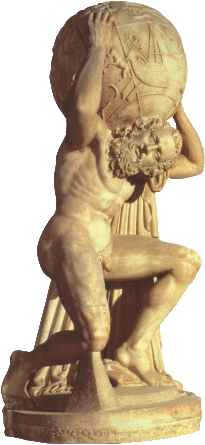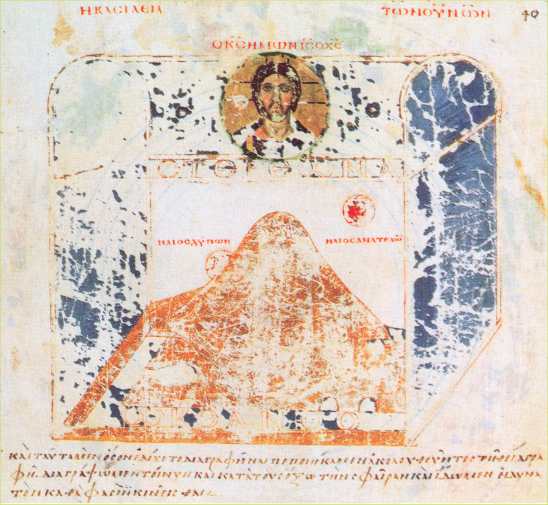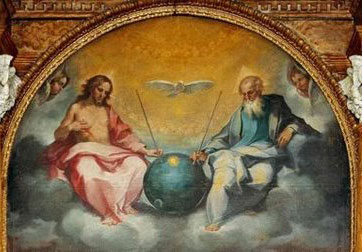|
The more gifted among human authors, such as Herman Melville, are capable of
writing at multiple levels and imbuing their works with esoteric, as
well as an obvious, meaning. God is similarly gifted. At its most
basic, literal level, it is a mistake to assume that all references
to the 'earth' are written from the standpoint of an observer
outside the system, whether he thinks the earth is a globe,
dish-shaped or whatever. This is simply not an available viewpoint
at that level. It is interesting to see how much meaning
sophisticated readers like Hugh Ross can find in the Genesis text;
these readers are not necessarily reading into the text or importing
foreign material, even though considerable time would inevitably
elapse until readers could catch up to the Author's level of
insight. However reading into the text an imaginary construct, the
'sky-dome,' believed in by none, shines no light and uncovers no
meaning.

Language as She is Spoke
The Bible nowhere teaches that the earth is flat nor that it is covered by an inverted Revere-ware bowl, painted blue. Atheists will sometimes concede that it doesn't teach this: there is no deliberate presentation of any such doctrine. This in
itself is odd given that atheists imagine such structures as the 'sky-dome'
to be at the heart of the religious enterprise. But they go on to accuse,
not any Bible author, but the Hebrew language of flat-earthism.
At this the reader must cry 'foul.' Though it is reasonable to expect a
thoughtful writer to choose words carefully, which includes being mindful
of their etymologies, it is not reasonable to expect any author, human
or divine, to offer a warranty behind the origin each and every word of
a language he or she consents to speak. No one ever makes this extravagant
demand in any other context, so why is it justified here? Etymologies are
always speculative; do you know the history of the English words you use,
and will you stand behind them? Adam gave names to the animals, he did
not learn their names from God. Gagging God in this way requires Him to
introduce a divine Esperanto to His prophets before He can communicate
with them, filled with newly coined words of immaculate descent. But how
will He teach this new language to His prophets, without using words from
the old? So He must use existing languages, all of whose words have a past,
perhaps even a sordid past. But all current words have outlived their past,
they have faced it down and gone onward; it is not entirely relevant, because words mean what they are used to mean; etymology belongs to history.
Most speakers are not even aware of etymology: "We must accept the
obvious fact that the speakers of a language simply know next to
nothing about its development; and this certainly was the case with
the writers and immediate readers of Scripture two millennia ago."
(Moises Silva, Biblical Words and Their Meaning, Kindle location 487).
Certainly the omniscient God knows what the immediate speakers may
or may not know; but why God would be presumed to 'mean' the
etymologies when no one else does is unclear.
The word 'firmament' is 'raqiya'. Atheists, going behind God's revelation to the vocabulary of the already
existing human language He employed, claim that on its face this word propounds
the 'sky-dome' theory. It means something beaten out, as gold into fine gold
leaf. This is why the word is often translated 'expanse': "Then God
said, 'Let there be an expanse in the midst of the waters, and let it separate
the waters from the waters." (Genesis 1:6 NASB). In Biblical meteorology,
there is a lower ocean, the surface waters...and an upper ocean, the clouds:
"Or who shut up the sea with doors, when it brake forth, as if it
had issued out of the womb? When I made the cloud the garment thereof,
and thick darkness a swaddling-band for it. . ." (Job 38:8-9). God used
this already existing word with clear meaning. If anyone asked, 'What is it?,' the speaker could point.
The atheists say, language speakers must at some point have believed
in a metal sky dome, or otherwise why use such a word? Perhaps to
point to the lack of granularity? Who knows?
Nor is it reasonable arbitrarily to rule out otherwise available uses of
language. Who propounded the rule that we can use simile and metaphor,
but God cannot? One paramount 'dome' proof-text is Job 37:18: "Hast
thou with him spread out the sky, which is strong, and as a molten looking
glass?". But we find similar imagery in modern poets. Was Coleridge
a flat-earther?: "All in a hot and copper
sky, The bloody Sun, at noon, Right up above the mast did stand, No bigger than the Moon."
(Samuel Taylor Coleridge, Rime
of the Ancient Mariner). What I think Coleridge meant by his "copper sky" is the shimmery, scintillating appearance of
a blindingly hot day when it is almost hurtful to look at the bright, searing sky, even away from the sun itself. Poets
signify this by visualizing the sky itself as a burnished reflector of highly polished metal: a "molten looking glass".
The Bible uses a range of descriptive imagery of the sky, including tents, curtains, fabric scrims, and garments:
"And all the host of heaven shall be dissolved, and the heavens shall be rolled
together as a scroll: and all their host shall fall down, as the leaf falleth off from the vine, and as a falling fig from
the fig tree." (Isaiah 34:4);
"Who coverest thyself with light as with a garment: who stretchest out the heavens
like a curtain:..." (Psalms 104:2);
"And, Thou, Lord, in the beginning hast laid the foundation of the
earth; and the heavens are the works of thine hands: they shall perish; but
thou remainest; and they all shall wax old as doth a garment; and as a
vesture shalt thou fold them up, and they shall be changed: but thou art
the same, and thy years shall not fail." (Hebrews 1:10-12).
So are these 'competing theories': the 'scroll' theory, the 'curtain' theory, and the 'garment' theory? Or just
mixed metaphors? None of the apocalyptic authors describe the banging and denting required to trash a metallic dome; had they
imagined there to be any such structure, they would have been obliged to bring suitable means to bear to demolish it. Yet
there's no mention of taking a wrecking ball to any solid 'sky dome'. Which is hardly surprising; probably they didn't even know
it was there...which it isn't.

Flat Earth and the Ptolemaic System
Atheists allege that the early church writers believed in a flat earth.
They will even tell you that everyone prior to the voyages of
discovery of Christopher Columbus and Ferdinand Magellan
believed the earth was flat. The ancients, all of 'em, were
flat-earthers. The modern academy is heavily invested in
promoting this Ripley's 'Believe it or Not' conception: "Of course,
Herodotus's world is still flat — that notion
would stand for another thousand years."
(Nell Irvin Painter, The History of White People, p. 222).
So they say. But is it so? Did the early church writers believe in a flat earth? Why, then,
do some early church authors, like Clement of Alexandria and Origen,
employ technical terminology of Ptolemaic astronomy? Believe it or not, the Ptolemaic
system features a round earth.
Not only did Claudius Ptolemy, who wrote in second century
Alexandria, think the earth was round, he had arguments for a round earth which are downright compelling:
"Now, that also the earth taken as a whole is sensibly spherical,
we could most likely think out in this way. For again it is possible
to see that the sun and moon and the other stars do not rise and set at
the same time for every observer on the earth, but always earlier for those
living towards the orient and later for those living towards the occident...And
since the differences in the hours is found to be proportional to the distances
between the places, one would reasonably suppose the surface of the earth
spherical...Again, whenever we sail towards mountains or any high places
from whatever angle and in whatever direction, we see their bulk little
by little increasing as if they were arising from the sea, whereas before
they seemed submerged because of the curvature of the water's surface."
(Ptolemy, Almagest, I.4).
Ptolemy's astronomy was not pre-scientific; it had high predictive value.
Those church writers who accepted it were doing no more than believing
the best secular science of their day. There's certainly room for improvement,
as Ptolemy's system is geocentric. But the flat earth of the atheists can't
be found therein.
Ptolemy's originality is difficult to gauge, because works by his predecessors
have been lost. Aristotle, who does not provide a detailed astronomy, does
however describe the earth as spherical:
"Either then the earth is spherical or it is at least naturally spherical...The
evidence of the senses further corroborates this. How else would
eclipses of the moon show segments shaped as we see them? As it is,
the shapes which the moon itself each month shows are of every kind straight,
gibbous, and concave -- but in eclipses the outline is always curved: and,
since it is the interposition of the earth that makes the eclipse, the
form of this line will be caused by the form of the earth's surface, which
is therefore spherical. Again, our observations of the stars make
it evident, not only that the earth is circular, but also that it is a
circle of no great size. For quite a small change of position to
south or north causes a manifest alteration of the horizon. There
is much change, I mean, in the stars which are overhead, and the stars
seen are different, as one moves northward or southward. Indeed there
are some stars seen in Egypt and in the neighborhood of Cyprus which are
not seen in the northerly regions; and stars, which in the north are never
beyond the range of observation, in those regions rise and set."
(Aristotle, On the Heavens, Book II, Part 14).
I've provided a copy of Aristotle's On the Heavens in the
Thriceholy library, in hopes of combating the persistent misperception that, prior to Copernicus, astronomers believed the earth was flat.
The Ptolemaic system is geocentric -- it situates the earth at the center -- but the earth in that system
is as round as in any other. Plato also describes a spherical world system:
"...and if a person were to go round the world in a circle, he would often, when standing at the antipodes of his former
position, speak of the same point as above and below; for, as I was saying just now, to speak of the whole which is in the form of a globe
as having one part above and another below is not like a sensible man."
(Plato, Timaeus, 63)
 Who started the trend? It is difficult to say, but Diogenes Laertius names Anaximander (611-546 B.C.) as a round-earther: "He held. . .that the earth, which is of spherical shape, lies in the midst, occupying the place of a centre; that the moon, shining with borrowed light, derives its illumination from the sun. . .He was the first to draw on a map the outline of land and sea, and he constructed a globe as well." (Diogenes Laertius, Lives of the Eminent Philosophers, Volume I, Book II, p. 131, Loeb edition.) Who started the trend? It is difficult to say, but Diogenes Laertius names Anaximander (611-546 B.C.) as a round-earther: "He held. . .that the earth, which is of spherical shape, lies in the midst, occupying the place of a centre; that the moon, shining with borrowed light, derives its illumination from the sun. . .He was the first to draw on a map the outline of land and sea, and he constructed a globe as well." (Diogenes Laertius, Lives of the Eminent Philosophers, Volume I, Book II, p. 131, Loeb edition.)
Not all the ancients were geocentrists. The
heliocentric hypothesis was formulated in antiquity by, among others, Aristarchus of Samos:
"His hypotheses are that the fixed stars and the sun remain unmoved, that the earth revolves about the sun in the circumference of a circle, the
sun lying in the middle of the orbit. . ." (Archimedes, The Sand-Reckoner, p. 420, The World of
Mathematics, Volume One, James R. Newman). The reasons why the early astronomers rejected the heliocentric hypothesis were not religious but physical. First, there was the lack of stellar
parallax: "The earth, then, also, whether it move about the center or as stationary at it, must necessarily move with two motions.
But if this were so, there would have to be passings and turnings of the fixed stars. Yet no such thing is observed. The same stars
always rise and set in the same parts of the earth. "
(Aristotle, On the Heavens, Book II, Part 14).
Passengers on a train watch telephone poles change their configurations
respective to one another as the train rolls through the countryside. If
the earth is moving through space, why is there no observable change in
the configuration of the stars? Ptolemy, too, notes the absence of
observable stellar parallax: "...in all parts of the earth the sizes
and angular distances of the stars at the same times appear everywhere
equal and alike...By the same arguments...it can be shown that the earth
can neither move in any one of the aforesaid oblique directions, nor ever
change at all from its place at the center." (Ptolemy, Almagest I.6-7).
Stellar parallax was not observed until the nineteenth century. This,
thought Ptolemy, was observational proof against the earth orbiting the
sun. To rebut this observational evidence, later astronomers hypothesized
immense distance: but is that parsimonious?
What about rotation? If the earth rotates, the ancients wondered,
why does a rock thrown upwards land directly beneath the point from which
it was thrown? "...for us to grant these things [earth's rotation],
they would have to admit that the earth's turning is the swiftest of absolutely
all the movements about it because of its making so great a revolution
in a short time, so that all those things that were not at rest on the
earth would seem to have a movement contrary to it, and never would a cloud
be seen to move toward the east nor anything else that flew or was thrown
into the air. For the earth would always outstrip them in its eastward
motion, so that all other bodies would seem to be left behind and to move
towards the west." (Ptolemy, Almagest I.7).
Copernicus bravely meets these objections head on: "Moreover, freely falling bodies would not arrive at the places appointed
them, and certainly not along the perpendicular line which they assume so quickly. And we would see clouds and other things floating
in the air always borne toward the west. For these and similar reasons they say that the Earth remains at rest at the middle of the world
and that there is no doubt about this." His answer: "And things are as when Aeneas said in Virgil: 'We sail out of the harbor,
and the land and the cities move away.' As a matter of fact, when a ship floats on over a tranquil sea, all the things outside seem to the
voyagers to be moving in a movement which is the image of their own, and they think on the contrary that they themselves and all the things
with them are at rest." (Copernicus, Revolutions of the Heavenly Spheres, I.7-8). It took Galileo's genius to work out this 'ship' analogy
in sufficient detail to quiet doubt. It was physics which lagged, not astronomy; no one in antiquity could explain how, on a moving earth,
a projectile thrown directly upwards would land at a spot directly beneath where it was thrown.
While various conformations of the earth had been suggested by the earliest
astronomers, Pliny reports no ongoing dispute:
"Of the Form of the Earth: Every one agrees that it has the most perfect
figure. We always speak of the ball of the earth, and we admit it to be
a globe bounded by the poles." (Pliny the Elder, The Natural History, 2.64).
Cicero too speaks of a globe: "Exile is terrible to
those who have, as it were, a circumscribed habitation; but
not to those who look upon the whole globe, but as one city [qui omnem orbem terrarum
unam urbem esse ducunt]." (Complete Works of Cicero,
Kindle location 47301, Paradoxes Addressed to Marcus Brutus, Paradox II). As Cicero describes it, the earth is "solid, round, and
conglobular: "First, let us examine the earth, whose situation
is in the middle of the universe, solid, round, and
conglobular by its natural tendency; clothed with flowers,
herbs, trees, and fruits; the whole in multitudes incredible,
and with a variety suitable to every taste: let us consider
the ever-cool and running springs, the clear waters of the
rivers, the verdure of their banks, the hollow depths of
caves, the cragginess of rocks, the heights of impending
mountains, and the boundless extent of plains, the hidden
veins of gold and silver, and the infinite quarries of
marble."
(Cicero, Marcus Tullius. Delphi Complete Works of
Cicero (Delphi Ancient Classics) (Kindle
Locations 57559-57563). On the Nature of the
God, Book II, Chapter XXXIX).
There were nay-sayers in the early church on the subject of Ptolemaic astronomy,
but the Ptolemaic system was generally popular, round earth and all. It
would later come to be much beloved by scholastics like Thomas Aquinas.
Reformers Martin Luther and John Calvin were also fond of it. Galileo's
conflict with Roman Catholic authorities over the moving earth of the Copernican
system has come, by some confused channel whereby atheist polemic bleeds
over into the 'history of science,' to be misunderstood as a dispute
over whether the earth is flat or round. There was no such dispute; the
scholastics describe a round earth.
The pagan philosopher Pythagoras was a 'round-earther:' ". .
.these elements interchange and turn into one another completely, and
combine to produce a universe animate, intelligent, spherical, with
the earth at its center, the earth itself too being spherical and
inhabited round about. There are also antipodes, and our 'down' is
their 'up.'" (Diogenes Laertius, Lives of the Eminent Philosophers,
Pythagoras, Chapter VIII, p. 343 Loeb).
Notice how Justin, and others amongst the earliest Christian apologists, quote with approval 'round earth' astronomy:
- “And Pythagoras agrees with him when he writes: — 'Should one in boldness say, Lo, I am God! Besides the One
— Eternal — Infinite, Then let him from the throne he has usurped put forth his
power and form another globe, such as we dwell in, saying, This is mine.'”
- (Justin on the Sole Government of God, quoting Pythagoras' testimony to
the one God, Chapter II).
- “Beautiful without doubt is the world, excelling, as well in its magnitude
as in the arrangement of its parts, both those in the oblique circle and
those about the north, and also in its spherical form.”
- (Athenagoras, A Plea for the Christians, Chapter 16).
- “Lord of the good, Father, of all the Maker, Who
heaven and heaven’s adornment, by Thy word
Divine fitly disposed, alone didst make; Who
broughtest forth the sunshine and the day; Who
didst appoint their courses to the stars, And
how the earth and sea their place should keep;
And when the seasons, in their circling course,
Winter and summer, spring and autumn, each
Should come, according to well-ordered plan; Out
of a confused heap who didst create This ordered
sphere, and from the shapeless mass Of matter
didst the universe adorn; — Grant to me life,
and be that life well spent, Thy grace enjoying;. . .”
- (Clement of Alexandria, Hymn to the Paedagogus, p.
584, ECF_0.02).
- “As, when the sun shines above the earth, the shadow
is spread over its lower part, because its spherical shape makes it impossible for it to be
clasped all round at one and the same time by the rays, and necessarily, on whatever side the sun’s
rays may fall on some particular point of the globe, if we follow a straight diameter, we shall
find shadow upon the opposite point, and so, continuously, at the opposite end of the direct
line of the rays shadow moves round that globe, keeping pace with the sun, so that equally in
their turn both the upper half and the under half of the earth are in light and darkness; so, by this
analogy, we have reason to be certain that, whatever in our hemisphere is observed to befall
the atoms, the same will befall them in that other.”
- (Gregory of Nyssa, On the Soul and the
Resurrection, p. 860, ECF_2.05).
- “For they say that the
circumference of the world is likened to the
turnings of a well-rounded globe, the earth
having a central point. For its outline being
spherical, it is necessary, they say, since there
are the same distances of the parts, that the
earth should be the center of the universe, around
which, as being older, the heaven is whirling.”
- (Methodius, Banquet of the Ten Virgins, Discourse
8, Chapter 14).
- “Thus we might, without self deception, define day as air
lighted by the sun, or as the space of time that
the sun passes in our hemisphere.”
-
(Basil, Hexaemeron, Homily 6, Section 8, p. 276, ECF_2.08).
- “For take, saith he, the comparison of ashes to a
house, of a house to a city, a city to a province,
a province to the Roman Empire, and the Roman
Empire to the whole earth and all its bounds,
and the whole earth to the heaven in which it is
embosomed; — the earth, which bears the same
proportion to the heaven as the center to the
whole circumference of a wheel, for the earth is no
more than this in comparison with the heaven:
consider then that this first heaven which is seen
is less than the second, and the second than the
third, for so far Scripture has named them, not
that they are only so many, but because it was
expedient for us to know so many only.”
- (Cyril of Jerusalem, Catechetical Lectures,
Lecture 6, Section 3).
- “. . .therefore I called Him
back as My true and beloved Son from the Egypt
whither He descended when He became man, meaning by
Egypt this earthly sphere, or possibly Egypt
itself.”
- (Eusebius of Caesarea,
Demonstratio Evangelica (The Proof of the Gospel),
Book IX, Chapter 4).
- “The sun and the moon have their
settled course. The stars move in no uncertain
orbits round this terrestrial globe.”
- (The Emperor Constantine, quoted in Eusebius, Life
of Constantine, Book Two, Chapter 58).
|
|
What you hear from the atheists is flat-out wrong: "All the early
Fathers naturally believed that the earth was flat." (H. L. Mencken, A
Treatise on the Gods, Kindle location 2922). The third-century Christian author Arnobius, debunking the pagan deities, one
of whom presided over the 'left hand,' explains why this deity is
somewhat beside the point in our spherical world,
"For in the first place, indeed, the world itself has in
itself neither right nor left neither upper nor under regions,
neither fore nor after parts. For whatever is round, and bounded on
every side by the circumference of a solid sphere, has no beginning,
no end; where there is no end and beginning, no part can have its
own name and form the beginning." (Arnobius, The Seven Books of
Arnobius, Book 4, Section 5, p. 891 ECF 0.06).
Later writers offer similar thoughts, taking for granted
the rotundity of the world:
“Ye have heard in the Psalm, 'I have seen the end of all perfection. He
hath said, I have seen the end of all perfection: what had he seen? Think
we, had he ascended to the peak of some very high and pointed mountain,
and looked out thence and seen the compass of the earth, and the circles of
the round world, and therefore said, 'I have seen the end of all
perfection'?” (Augustine, Homily on First John 5:1-3, Ten Homilies on
First John, Homily 10.5).
Though Augustine shares Lactantius' dislike for the antipodes, he concedes the rotundity of the earth:
“But they do not remark that, although it
be supposed or scientifically demonstrated that the world is of a
round and spherical form, yet it does not follow that the other side of the
earth is bare of water; nor even, though it be bare, does it
immediately follow that it is peopled.” (Augustine,
The City of God, Book 16, Chapter 9).
To close with Jerome, on the verge of the medieval period:
“Hardly had she escaped from the hands of the barbarians, hardly had she
ceased weeping for the virgins whom they had torn from her arms, when
she was overwhelmed by a sudden and unbearable bereavement, one too
which she had had no cause to fear, the death of her loving son. Yet as one
who was to be grandmother to a Christian virgin, she bore up against this
death-dealing stroke, strong in hope of the future and proving true of
herself the words of the lyric:
“Should the round world in fragments burst, its fall
May strike the just, may slay, but not appall.”
(Jerome, Letters, Letter CXXX, Chapter 7, p. 589, ECF_2_06).
“The whole world groaned, and was astonished to find itself Arian. [Ingemuit
totus orbis, et Arianum se esse miratus est.]” (Jerome,
Dialogue Against the Luciferians, Chapter 19).
It is a round world, after all, 'orbis' like the man says,
which when you stop to think about it is a peculiar word for flat-earthers
to be using for the world; our word 'orb' comes from the Latin orbis.
The atheists visualize a half-dome covering a flat surface and
try to find it where they may. The sky above us does seem to convey,
by its appearance, a spherical look and feel, though under the
Copernican system of astronomy, this can only be an optical
illusion. The popularity of domed structures, from the Pantheon
forward, is probably related to this conception: "Mankind has built
domed structures for over two thousand years and learned to
attribute to their geometry very particular psychological
properties. As a source of messages the architectural dome is
related to the celestial sphere, which can be interpreted as a dome
of infinite magnitude covering the whole of humanity. . .No other
surface can give the same feeling of protection because the sphere
is the only surface that comes down equally all around us. . .The
dome sends a complex and ambiguous message, composed of amazement,
awe and serenity." (Mario Salvadori, Why Buildings Stand Up, p.
278). Though a domed roof is, of necessity, never a complete sphere,
what the people who built these structures were actually thinking of
is a little different. The atheists seem strangely oblivious to the
persistence, for centuries, of a system of astronomy which featured
a whole-dome, or rather a series of nested concentric domes,
surrounding the earth. Unknown to them, what was matched with the
celestial sphere, fittingly enough, was a rotund, spherical earth.
This system is described, not only in technical literature
intended for astronomers, but in popular works addressed to the
public at large, both in antiquity and also during the Middle Ages;
think of Dante, with his layered (Ptolemaic) universe:

|













